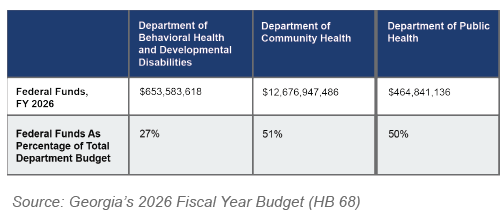Read More of the 2026 Budget Primer here.
Georgia’s 2026 Health Budget
The Departments of Behavioral Health and Developmental Disabilities (DBHDD), Community Health (DCH) and Public Health (DPH) are the primary agencies focused on the state’s health care and public health systems. Georgia plans to provide almost $7.7 billion in state funds for these three agencies. General fund appropriations account for $6.9 billion, or about 90%, of their state funding. Other sources, like Tobacco Settlement Funds, account for the remaining $799 million in state funds. Overall, state funds for these three agencies increased by $353 million, or 5%, from the original FY 2025 budget.
The Department of Community Health (DCH) accounts for about $5.6 billion, or 72%, of state health spending. The Department of Behavioral Health and Developmental Disabilities (DBHDD) accounts for about $1.7 billion, or 22%, of state spending on health. The Department of Public Health (DPH) accounts for $435 million, or about 6%, of state spending on health.
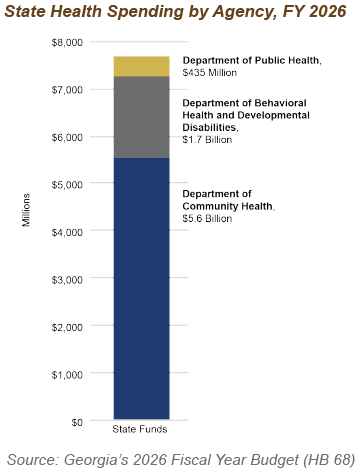
The Department of Community Health FY 2026 Budget
The Department of Community Health (DCH) administers the state’s health care safety net, reimburses hospitals for services provided to uninsured and underinsured Georgians, manages health insurance coverage for state and school system employees and regulates health and long-term care facilities. The FY 2026 budget provides the Department with almost $5.6 billion in state funds. That includes almost $4.8 billion in state general funds and about $756 million in Tobacco Settlement Funds, ambulance provider fees, nursing home provider fees and hospital provider fees. The budget increases the Department’s state funding by $291 million, or less than 6%, above the original FY 2025 budget.
About 94% of the Department of Community Health’s overall state funding is earmarked for Medicaid and PeachCare, which provide health care coverage to about 2 million Georgians with lower incomes. Although most enrollees are children under the age of 19, more than half (55%) of FY 2026 state funds for Medicaid and PeachCare support coverage for older adults and individuals with disabilities.
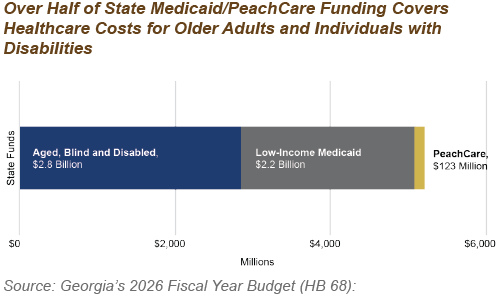
Modest Increases Improve Medicaid Provider Rates and Set Course for Eligibility and Enrollment System Improvements, But Health Insurance Coverage Gap Remains
Increasing Provider Rates
Increasing Medicaid reimbursement rates, which tend to be lower than Medicare and commercial rates, can improve access to care. The Department of Community Health (DCH) FY 2026 budget includes about $23 million in additional state funds to support provider rates increases. The largest line items impact provider rates for emergency medical transportation, therapy for children with autism, newborn deliveries in rural counties and primary care.
Strengthening Eligibility and Enrollment Infrastructure
The unwinding of pandemic-era Medicaid continuous eligibility and the launch of Georgia’s Pathways to Coverage program highlighted and exacerbated longstanding weaknesses in the state’s eligibility and enrollment infrastructure. Georgia’s outdated technology can create issues for both enrollees and state agency workers that prevent eligible Georgians from accessing coverage and generate unnecessary state costs. The AFY 2025 budget included $35 million (and forecasts the allocation of another $35 million in a future budget cycle) for the Georgia Technology Authority that will support activities overseen by DCH to replace the current system, known as Gateway. This modernization effort represents an important step toward simplifying application, enrollment and renewal processes for Medicaid and other public benefits programs.
Continuing to Invest in the Pathways to Coverage program
Despite having one of the highest uninsured rates in the country, Georgia is 1 of 10 states that have not fully closed the health insurance coverage gap. Georgia’s FY 2026 budget for the Department of Community Health reflects a continued investment in the Pathways to Coverage program, which provides Medicaid coverage to low-income, uninsured adults contingent upon reporting 80 hours per month of work, higher education, volunteering or some other qualifying activity. Although an estimated 240,000 are potentially eligible for the program, Pathways to Coverage will only cover about 30,000 Georgians at full implementation (according to the state’s 1115 demonstration waiver extension application). Because Pathways to Coverage does not qualify for the enhanced 90% federal match for states who expand coverage of adults earning up to 138% of the federal poverty level, Georgia is paying more per person and missing out on downstream economic benefits, including between $112 – $285 million in additional state revenue as estimated by the state auditor.
The Department of Public Health FY 2026 Budget
The Department of Public Health (DPH) operates programs focused on disease and injury prevention, health promotion and health-related disaster response and preparedness. The FY 2026 budget provides the Department with about $435 million in state funds. That includes almost $403 million in state general funds and almost $14 million in Tobacco Settlement Funds. Also included is about $18 million in combined Brain & Spinal Injury Trust Funds and Trauma Care Trust Funds for attached agencies.
The budget increases the Department’s state funding by about $3 million, or less than 1%, above the original FY 2025 budget. Much of this increase is accounted for by an increase for the perinatal home-visiting pilot project that was launched in FY2024 and will expand to provide support to pregnant women and their infants in 75 rural counties. The largest state-funded programs support 159 county health departments, provide services for children and help track and prevent the spread of infectious diseases.
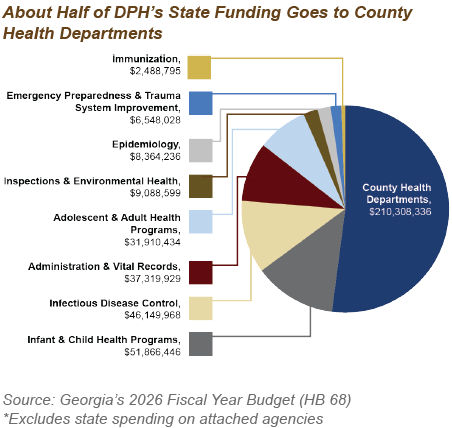
The Department of Behavioral Health and Developmental Disabilities FY 2026 Budget
The Department of Behavioral Health and Developmental Disabilities (DBHDD) provides services primarily for uninsured and underinsured Georgians living with mental health conditions, substance use disorders and developmental disabilities. It operates state hospitals and provides community-based services through contracted providers. The Department also operates forensic evaluation and treatment programs under the court system’s jurisdiction. The FY 2026 budget provides the Department with over $1.7 billion in state funds. That includes almost $1.7 billion in state general funds and about $10 million in tobacco settlement funds.
The FY 2026 budget increases the Department’s state funding by about $59 million, or less than 4%, above the original FY 2025 budget. Much of this increase is accounted for by reimbursement rates increases originally added in the FY 2025 budget. The FY 2026 budget annualizes reimbursement rate increases for providers who serve individuals with intellectual and developmental disabilities in their homes and communities and for providers who deliver community-based preventive or rehabilitative services to individuals with mental health issues or substance use disorders. Overall, the largest state-funded programs fund evaluation and treatment as well as both institutional and community-based care for children, adolescents and adults with either mental health issues or disabilities.
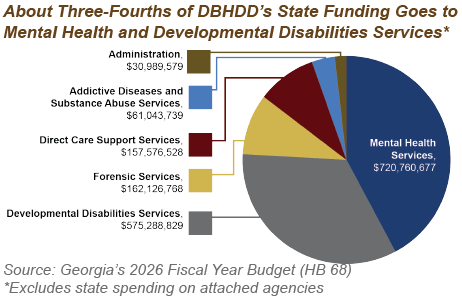
Federal Funds Support Critical Health Programs
Federal funds account for a substantial proportion of each health agency budget. The three primary health agencies expect to receive almost $14 billion in combined federal support in FY 2026 – most of which is accounted for by the federal matching funds for Medicaid. The Department of Health and Human Services (HHS) is the largest federal funding source for both DBHDD and DCH. Special Supplemental Nutrition Program for Women, Infants, and Children (also known as WIC) funding from the U.S. Department of Agriculture is one of the largest federal funding sources for the Department of Public Health along with other large grants from HHS. Among other programs, federal funds play an outsized role in:
- Healthcare coverage for low-income Georgians
- Community-based services for adults with intellectual and/or developmental disabilities
- Substance abuse prevention services
- Public health programs for infants and children, like early intervention services and nutrition support, and for emergency preparedness
